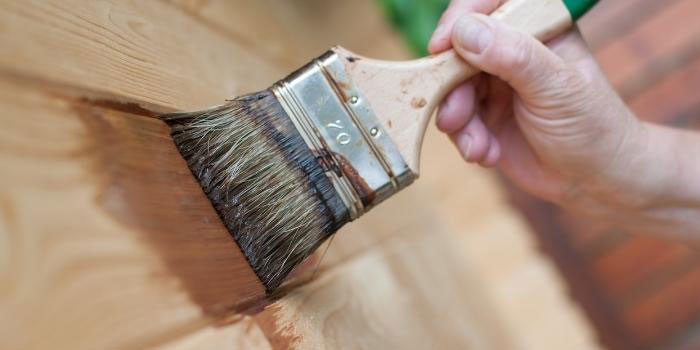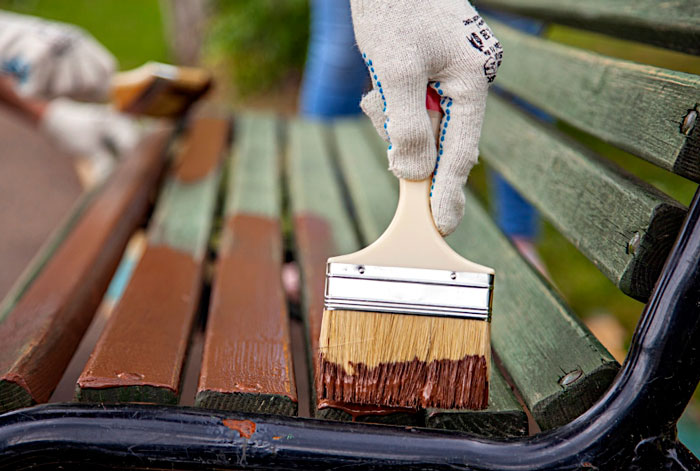Can You Paint Damp Wood? Everything You Need To Know About It
Maybe you have a wooden project that needs to be finished quickly. Or, maybe you live in a humid area where wood never seems to dry completely. In any case, you might have to paint on wet wood materials.
But can you paint damp wood? The short answer is yes. You can paint acrylic, latex, or vinyl-based paints on damp wood because these are water-based paints.
Now, want to learn more about painting damp wood? In a moment, we’ll talk about everything you need to know about this. We will provide you with an in-depth guide on how to paint damp wood successfully. So, let’s get started!
Can You Paint Damp Wood And Why?
As already mentioned, you most certainly can paint on damp wooden materials.
The main reason why you can do this is because some types of paint are specially designed to adhere to wet surfaces. These paints are usually water-based, such as acrylic, latex, or vinyl.
They have a high amount of solids and binders, which help them stick to the wood fibers and form a durable film. For example, according to Dunn Edwards, 100% acrylic binders provide the best adhesive for paints in both wet and dry conditions.

They also have a low amount of solvents and water, which reduces the risk of blistering and peeling. These paints can tolerate a moisture content of up to 20% in the wood.
However, not all types of paint can be used on damp wood. Oil-based paints, such as alkyd or enamel, are not suitable for wet surfaces.
They have a high amount of solvents and oil. This prevents them from bonding with the wood fibers and causes them to slide off. They also have a low amount of solids and binders. This makes them prone to cracking and fading.
These paints require a moisture content of less than 15% in the wood. Therefore, the type of paint you use is crucial for painting damp wood.
You should always test the paint on a small area of the wood before applying it to the whole surface. This will help you avoid any unpleasant surprises and ensure a good result.
Are There Any Risks Of Painting Damp Wood?
In very limited cases, painting damp wood can have some risks that can affect the quality and durability of the paint job. Some of the most common risks are:

1. Peeling: This occurs when it is too wet (more than 20% moisture content).
2. Cracking: This occurs when the paint dries too fast and shrinks, causing it to crack and split. This can happen because the paint is exposed to extreme temperatures or sunlight.
As directed by Dulux, the temperature range of 68°f (20ºC) to 77°f (25ºC) and relative humidity of 50% is the ideal environment for painting.
3. Mold growth: This occurs when the paint traps moisture inside the wood. This can happen because the paint is not breathable enough or the paint is applied over existing mold or dirt.
4. Rotting: This is seen when the wood is not treated with a preservative. Rotting can also happen due to the paint not protecting the wood from moisture. Or the paint is damaged by insects or animals.
What Types Of Paint Can Be Used On Damp Wood and Why? (In-depth Explained)
As we mentioned before, the type of paint you use is crucial for painting damp wood. You should always choose a paint that is compatible with the wood, such as the ones below:
1. Acrylic paint:
This is a water-based paint that contains acrylic resin as the main binder.
Because of this, it is one of the best options for painting damp wood, as it has high adhesion, flexibility, and durability.
It can resist peeling, cracking, and fading, as well as mold and mildew growth.

2. Latex paint:
This is another water-based paint that contains latex rubber as the main binder.
Latex paint is similar to acrylic paint in many aspects, such as adhesion, flexibility, and durability.
It also dries quickly and can be applied with a brush, roller, or sprayer.

3. Vinyl paint:
This is a water-based paint that contains vinyl acetate as the main binder.
Due to the widespread availability of vinyl acetate, it is a cheaper alternative to acrylic or latex paint. But it has a lower quality and performance compared to the other two.
It has moderate adhesion, flexibility, and durability. But it can peel, crack, and fade more easily.

How To Paint Damp Wood? (Step by Step Guide)
Here are the main steps you should take to paint damp wood successfully:
Step 1 – Dry the wood:
The first step is to dry the wood as much as possible before painting it. You can use a dehumidifier, a fan, a heater, or a hair dryer to speed up the drying process.
You can also use a moisture meter to measure the moisture content of the wood. Ideally, you should aim for a moisture content of less than 20% for water-based paints.

Step 2 – Clean the wood:
The second step is to clean the wood surface from any dirt, dust, grease, mold, or mildew. It might interfere with the paint adhesion.
You can use a mild detergent, a bleach solution, or a fungicide to remove any contaminants.
You should also sand the wood lightly to smooth out any rough edges or splinters.
You should wipe the wood with a damp cloth after cleaning and sanding it.
Step 3 – Prime the wood:
The third step is to apply a primer to the wood surface to seal it and prevent any moisture from seeping through.
Rawlinspaints suggest that it is needed for the adhesion of the paints.
You should use a primer that is compatible with the type of paint you are using and the type of wood you are painting.
For example, if you are using acrylic paint on pine wood, you should use an acrylic primer. If you are using latex paint on cedar wood, you should use an oil-based primer.
Step 4 – Paint the wood:
The fourth and final step is to apply the paint to the wood surface. You should use the paint we suggested above for damp wood, such as acrylic, latex, or vinyl paint.
You should also use a brush or roller to apply the paint and apply thin and even coats of paint. Remember to let each coat dry completely before applying another one.

FAQs
Here are some quick questions that might pop up in your mind.
1. How long does it take for the paint on damp wood to fully set?
There is no definitive answer to how long it takes for the paint on damp wood to fully set. However, a general rule of thumb is that water-based paints take about 24 hours to dry and 7 days to cure. According to Dulux, the final step of hardening takes 1 or 2 weeks.
2. Can I paint damp wood with a sprayer?
Yes, you can paint damp wood with a sprayer. You should also use a sprayer that is suitable for water-based paints and has an adjustable nozzle and pressure control.
3. Can I paint damp wood without sanding it?
You cannot paint damp wood without sanding it first. Sanding is an essential step in preparing damp wood for painting. Because it helps to smooth out any rough edges or splinters that might interfere with the paint adhesion.
Final Words
In essence, painting damp wood is indeed possible. But it does require some extra care and attention. You should always choose a paint that is compatible with damp wood and exterior use, such as acrylic, latex, or vinyl paint. You should also prepare the wood surface properly by cleaning it, sanding it, and priming it.
By following these guidelines and tips, you can successfully paint damp wood and achieve a good result. It will surely last for a long time. Happy painting!




